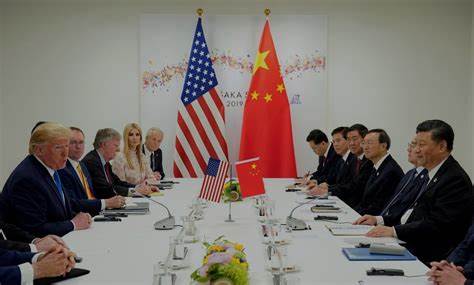The predominance of nation-states in the 21st century is the continuation of a trend set by “archaic globalisation”, dating back to thousands of years. Shipping routes and natural resources which were primary reasons back then, continue to hold high importance even in today’s technologically revolutionised world. Consequently, the international world order today is shaped by the economic, military and strategic relevance of countries and regions. Such can be seen in the (not so) curious case of the Pacific Islands. Over the last five months, the Pacific Island countries have witnessed increased levels of attention from international media, experts, world leaders, international forums etc., unlike in the past. The renewal of this latent attention in the South Pacific region by powerful regional players like Australia, the US, New Zealand and now China was last witnessed at the time of World War II, rendering them a prominent denominator in the ongoing power contest between the US and China.
The beginning of this renewed attention owes to the security pact signed between Solomon Islands (SI) and China back in April 2022. The security pact was aimed at filling the gap left after the Regional Assistance Mission to Solomon Islands (RAMSI) ended in 2017, following which clashes and violent episodes resurfaced in the island nation. Internal conflict and ethnic violence have plagued Solomons for nearly three decades, resulting in Australia and New Zealand initiating financial and security assistance in the region under RAMSI in 2003. These developed nations infused over USD$3 billion into the peacekeeping operations over a period of 17 years to restore social order and stability, build stronger institutional mechanisms and re-establish functionality.
Details of the security pact signed between China and Solomon Islands were kept hidden from the world, including the Pacific Islands Forum, which sent shockwaves not only within the Forum, but also among regional powers like the US. Speculation was rife that the pact could possibly allow Chinese warships to dock on the Solomon Islands. Furthermore, the Chinese efforts to persuade the Pacific Island nations to endorse the Common Development Vision (CDV), a sweeping agreement covering everything from security to resources, also alerted the traditional powers in the South Pacific. Nevertheless, Beijing could hold fast to its position that employing military power and securing stability in the Solomon Islands is a matter of Chinese national interest, allowing it to protect its personnel as well as the economic assets it is investing towards.
It is important to contextualise China’s proactiveness in the Solomon Islands strategically and economically. On the strategic front, the PI offers China an opportunity to turn the South Pacific into a ‘strategic choke point’ for both Australia and the US if they ever intended to make their way to East Asia for force projections in times of conflict. Although this futuristic rationale should not be discounted, it does not account for the whole picture. PI’s wealth of marine resources and crucial sea lanes of communication makes the region even more appealing for China, leading to increased investments since 2006. Though China is only the third highest investor in the region after the US and Australia, it has played a silent and agile game, gradually escalating engagement with PI nations such as Micronesia, Papua New Guinea, Vanuatu, Fiji, Niue, Cook Islands, Samoa, Kiribati, Solomon Islands and Tonga, particularly on the condition that they after the endorse the One-China policy.
Xi Jinping recently stated that China’s proposition of the Belt and Road Initiative (BRI), the Common Development Vision (CDV) as well as the latest Global Security Initiative (GSI) will “contribute to mustering consensus and strength in solving global challenges for growth and security”. The BRI acts as the economic plank of China’s foreign policy engagements, whereas the GSI, announced in April 2022, was a call to adhere to a new international order by rejecting zero-sum games and the US hegemony and providing Chinese solutions to international security challenges. Although by 2020, China had managed to on-board 12 Pacific Island nations to the BRI, it is struggling to acquire similar confidence among PIF leaders in the other two initiatives. At present, the PIF leaders are predominantly focused on climate change, development and regional stability. The PIF leaders are proceeding with caution regarding the nations’ involvement with China.
The Pacific Islands have witnessed economic and geopolitical implications on countries that have been deeply involved with China through BRI, directly or indirectly. Coupled with prioritising national and regional interests and stability, the PI nations are also cognizant of China utilising its initiatives as strategic tools to counter US hegemony. Therefore, so far the countries in PI have remained independently judicious in their foreign policy. They have kept their national interests at the forefront and stayed away from becoming pawns in the China-US great power rivalry.
PI nations who have strong economic and commercial ties with China will continue down that path of engagement for economic and regional development, through post-pandemic economic recovery, and building new centres for agriculture and disaster. However, their area of cooperation in sectors of security will be dictated by the larger geopolitics and great power rivalry in the region.
The current framework of China’s GSI does not have many enthusiastic takers in the Pacific region. China’s recent initiatives and attempts to introduce themselves into the region, and resuscitated interest of the West in the South Pacific provide PIF leaders an opportunity to leverage such renewed interest for their own gains.
Meanwhile, for China to succeed it must give utmost importance to the power of consensus within the PIF before making its next move. Otherwise, the alternate route of divide and conquer will take years before the PI nations come on board individually one by one. As for the West, they must start working seriously with the island countries on matters of climate change and regional development if they wish to continue being important players in the South Pacific. Western nations must remember that China will bring modified, more suitable deals in the future to the PI nations. Non-agreement to CDV is not the last of it.
China will ramp up its security, economic, commercial, logistical and diplomatic efforts to bring a more acceptable deal. Therefore, they need to stop waiting for China to start dominating the region, and instead take a more proactive role in tackling the challenges of the region.
Sharon Susan Koshy is a Research Associate at Centre for Public Policy Research, Kochi. Akanksha Gupta is a Senior Associate at Centre for Public Policy Research, Kochi.

















